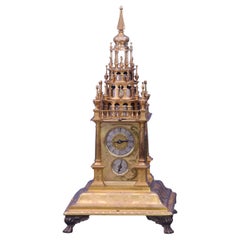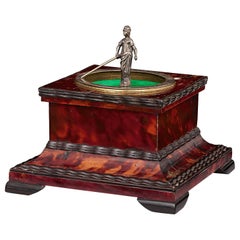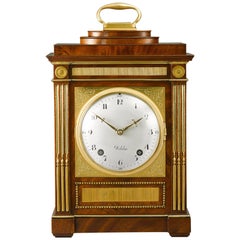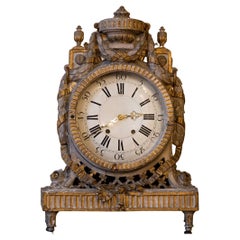German Clocks
9
to
2
5
4
9
9
9
2
1
1
9
69
231
4
21
146
57
6
1
3
18
1
28
52
27
9
Height
to
Width
to
7
6
4
3
2
35,451
416
202
119
94
1
1
Period: 18th Century and Earlier
Place of Origin: German
Rare c.1630 Augsburg Quarter-Striking Table Clock by Samuel Haug.
Located in Greenlawn, NY
Maker:
Samuel Haug, Augsburg. Germany.
Description:
An early 17th century gilt-copper quarter-striking table clock with alarm and adjustable striking by Samuel Haug of Augsburg.
...
Category
17th Century Other Antique German Clocks
Materials
Bronze
A Very Large Rare Meissen Porcelain 3 Piece Clock & Candelabra Garniture Set
By Meissen Porcelain
Located in New York, NY
A Very Large and Rare German Ormolu Mounted Meissen Porcelain Three Piece Clock & Candelabra Garniture Set. This impressive set consists of three pieces: a center clock and two candelabras, each adorned with the most intricate and delicate details that have been executed to perfection. Each three armed candelabra is remarkably elaborate with foliate arms that are embellished with gilt-covered beautifully twisted branches and curling leaves on an ornate botanically-inspired base. Embraced by the arms of the candelabras are two 18th Century Meissen Porcelain figures of musical lovers, dressed in brightly detailed traditional clothes.
The round clock face, with roman numerals, a white base, and ornate hands is surrounded by a flourish of gorgeous gilt foliage, exuding an air of elegance and refinement. Perched atop the clock is a stunning Meissen Porcelain figurine of a beautiful woman posed in mid-movement, her dress aflutter, and baring her leg as she gazes up at her left hand which is holding a bunch of grapes, while also grasping a wine goblet in her lowered right hand, representing the festivities of the moment. Surrounding the clock and extending down both sides the gilt foliate leads the eye to two cherubs each admiring tiny vases of exquisitely detailed flowers. Below the cherubs, on either side, are four white ceramic pillars...
Category
1760s Louis XVI Antique German Clocks
Materials
Bronze
18th Century German Grandfather Clock
Located in Tarry Town, NY
Mid 18th century walnut wood framed German 8-Day Grandfather clock. The tall case clock featured a dark walnut case with flared base, hood with half-columns and turned finials. Iron ...
Category
1750s Antique German Clocks
Materials
Brass
Meissen Mantel Table Clock Bronze Porcelain Autumn Fall Kaendler, circa 1745
By Johann Joachim Kaendler
Located in Vienna, AT
Meissen gorgeous rococo mantel / table clock made of gilded / gilt bronze, excellently decorated with sculptured figurines made of porcelain.
Manufactory: Meissen
Hallmarked: Blue M...
Category
1740s Rococo Antique German Clocks
Materials
Brass, Bronze, Enamel
Buschman “Minerva” German Horizontal Table Clock
Located in New Orleans, LA
The extraordinary beauty and superior craftsmanship of 17th century German clockmaking is on full display in this exceptionally rare horizontal tabletop timepiece dating to 1650 Augsburg. Created by Johannes Buschman the Younger, the eminent Buschman family of clockmakers are lauded for designing some of the finest timepieces to ever be created in the South German town of Augsburg during the late Renaissance and early Modern periods. A finely moulded ebony and turtleshell casing veneered in a mottled red hue holds the clock’s fusée and chain movement with verge escapement and balance with hogs-bristle regulation. A silver figure of Minerva, Roman goddess of war and wisdom, centers the Roman numeral-engraved chapter ring, indicating the time by pointing to the hour with an authoritative military staff as the sun rotates below her feet to indicate the minute. The incredible design is finished by a gilded backplate intricately pierced and engraved with a floral motif and the signature of Johannes Buschman.
Clocks are one of the greatest and most important inventions of the Renaissance period, improving steadily into the Age of Discovery. Embodying a renewed interest in science, the arts and humanism, the first mechanical timepieces began appearing in the 14th century and were large, weight-driven devices placed in the turrets of public buildings that struck the hour and lacked hands and faces. This clock was created during the first period of household clocks, when spring-driven movements made it possible to create smaller and more complex mechanisms. Such creations, however, were a luxury accessible only to the wealthy upper classes. Affluent patrons placed pressure upon artisans to create more elaborate and ornate clocks...
Category
17th Century Renaissance Antique German Clocks
Materials
Silver
Important German Neoclassical Table Clock by David Roentgen
By David Roentgen
Located in Worpswede / Bremen, DE
An important and rare table clock from the workshop of David Roentgen. The case with an oval stepped plinth top with gilt bronze handle, decoration of the case with ormolu mille raie banding, beaded edges and brass fluted columns to the front flanking the square brass dial, foliate engraved spandrels to the corners, centred by the white enamel Arabic chapter ring, signed Delolme, pierced brass hands, convex glazed bezel, square plated eight-day movement with four back-pinned pillars, verge escapement, silk suspension, rack and count wheel strike, striking the hours and quarters on two bells above, the back plate also signed, glazed side panels.
There is only a small series of comparable table clocks from the workshop of David Roentgen known. The present clock seems to be the first example of the cooperation between David Roentgen and the court clockmaker Delolme in Brunswick. The case is meticulously crafted and both case and movement are of superb quality.
David Roentgen, called the "most celebrated ébéniste in Europe" by his contemporaries, was a successful entrepreneur who transformed the business founded by his father, Abraham Roentgen...
Category
Late 18th Century Neoclassical Antique German Clocks
Materials
Bronze
German Marquetry Longcase Clock by Johann Wilhelm Wellershaus, Late 18th Century
Located in Berlin, DE
German Marquetry Longcase Clock by Johann Wilhelm Wellershaus, Late 18th Century
A German arched veneered longcase clock or Grandfather clock...
Category
Late 18th Century Louis XVI Antique German Clocks
Materials
Brass, Enamel, Iron
German Mahogany Tall Case Flute Clock
By A. Belokopytoff
Located in Hollywood, SC
German mahogany tall case flute clock with original painted ,gilt, and porcelain dial surrounded by original hand blown glass. The upper section has four ...
Category
18th Century and Earlier Antique German Clocks
Materials
Mahogany
Louis Seize Mantel Clock, Southern, Germany, circa 1780
Located in Greding, DE
Louis Seize pendulum with enamelled dial with Roman hours and Arabic minutes in a carved wooden case with gold-patinated elements.
Category
18th Century Antique German Clocks
Materials
Wood
Related Items
18th Century Grandfather Clock "Liverpool Made Case" from the George III Times
Located in Opole, PL
18th Century Grandfather Clock "Liverpool Made Case" from the George III Times
The case is a traditional Liverpool made one, as Liverpool cases of that period are probably the fines...
Category
Early 18th Century George III Antique German Clocks
Materials
Mahogany
H 84.65 in W 19.69 in D 10.04 in
Antique German Three Piece Porcelain Clock Garniture
Located in Montreal, QC
For those who enjoy the fine quality of blue and white German porcelain from the middle of the last century, this is a particularly fin...
Category
1880s Baroque Antique German Clocks
Materials
Porcelain
19th Century French Comtoise Grandfather Clock
Located in Winter Park, FL
A 19th century Country French comtoise, or grandfather clock, with pine case and embossed brass pendulum. The case is from Normandy circa 1900-1920 and the movement is from Marseille...
Category
19th Century French Provincial Antique German Clocks
Materials
Brass, Enamel
Victorian Mahogany Cased French Striking Mantel Clock
Located in Norwich, GB
Mahogany mantel clock in a break arch case with brass columns to either side, brass inlay to the front and surmounted by four brass finials.
Beautifully d...
Category
1870s Victorian Antique German Clocks
Materials
Mahogany
Large Rococo Style Porcelain Mantel Clock by Meissen
By Meissen Porcelain
Located in London, GB
Large Rococo style porcelain mantel clock by Meissen
German, 19th century
Measures: Height 66cm, width 33cm, depth 25cm
This superb mantel clock is a truly wonderful example of ...
Category
19th Century Rococo Antique German Clocks
Materials
Porcelain
Scottish Grandfather Clock
Located in New York, NY
Scottish Grandfather clock:
Clock face painted with settings of the Fair Maid of Perth during the four seasons.
Measures: 21" x 9" x 76"
Weighs: 50 Lbs.
Category
19th Century Antique German Clocks
Materials
Wood
1930s Wall Clock Kienzle, Germany
By Kienzle Clocks
Located in Praha, CZ
- Germany wall clock from 1930s Kienzle
- Very good original condition, with front glass dial
- Original chimes was cleaned and oiled
- The clock is in very good working condition...
Category
1930s Art Deco Vintage German Clocks
Materials
Metal
1930s Art-Deco wall clock, Germany
By Kienzle Clocks
Located in Praha, CZ
- German wall clock
- the clock is in good condition
- the front dial has been restored
- the chimes have been completely cleaned and oiled.
- The clock is mechanical and is wound w...
Category
1930s Mid-Century Modern Vintage German Clocks
Materials
Metal
Rare 1980s battery-operated world time table clock by Kienzle
By Kienzle Clocks
Located in München, DE
Rare 1980s brass world time table clock by Kienzle.
Goes back to the design of Heinrich Johannes Möller. Made in Germany.
Kienzle is the oldest clock company in Germany.
Housing is m...
Category
1980s Regency Vintage German Clocks
Materials
Metal, Brass
Very Large 19th Century Clock Garniture
By Napoléon III
Located in London, GB
A wonderful garniture in marble and ormolu, the central clock face engraved in ormolu and surrounded by enameled numerals. The clock is adorned by two amorous ormolu figures of an an...
Category
Late 19th Century Napoleon III Antique German Clocks
Materials
Bronze
Victorian Walnut Cased Striking Mantel Clock
Located in Norwich, GB
Late Victorian walnut break arch mantel clock standing on a raised plinth and resting on four outswept gilded paw feet and surmounted by four flame finials and a central finial.
H...
Category
19th Century Victorian Antique German Clocks
Materials
Walnut
Midcentury Kienzle Brass Table Clock, Heinrich Moeller Style, Germany, 1950s
By Friedrich Wilhelm Möller, Kienzle Clocks
Located in Vienna, AT
An elegant Mid-Century Modern desk or table clock with a mechanical 8-days movement from the 1950s. Executed by Kienzle Germany. This charming clock has a partly polished brass housi...
Category
Mid-20th Century Mid-Century Modern German Clocks
Materials
Brass
Previously Available Items
Louis Seize Mantel Clock, Southern, Germany, circa 1780
Located in Greding, DE
Louis Seize pendulum with enamelled dial with Roman hours and Arabic minutes in a carved wooden case with gold-patinated elements.
Category
18th Century Antique German Clocks
Materials
Wood
Rare South German Pendulum Clock Signed "Joseph Graff" C1750
By Joseph Graff
Located in valatie, NY
Rare and Historically Significant South German Pendulum Clock Signed "Joseph Graff, Prag No 136", C1750 the brass and tortoise inlaid case with finial top above the gilt brass and painted Roman numeral dial with moon face, date, and turning jeweled decorated escapement, with two subsidiary dials for strike/silent controlling the quarter and hourly strike. The original 30 hour verge movement with cable fusees and two spring driven chains is quarter-chiming on two bells and has a pull-cord strike release. Both the front dial and back plates are profusely engraved, gilded and signed by Graff. The front has openings for fazes of the moon, and two openings for the strike/silent controls for the quarter strike as well as the hour, the jeweled escapement is set with 18 original paste diamonds.
Joseph Graff is considered to be one of the greatest European clock...
Joseph Graff is considered to be one of the greatest European clock...
Category
18th Century and Earlier Antique German Clocks
German Renaissance Turret Clock
Located in New Orleans, LA
This immensely rare Renaissance turret-form clock, or the table clock, was considered both a scientific marvel and an item of luxury during the period. This incredible piece is encased in fire gilt brass crafted to resemble the giant striking clocks set within the turrets of buildings in the center of town. The mechanism strikes on the hour and quarter hour with an alarm feature. The movement is a gut/fuseé for going and striking train, a barrel for the alarm, a verge escapement and a foliot with a hog's bristle regulator complete with one hammer and one bell.
Clocks are one of the greatest and most important inventions of the Renaissance period, embodying the renewed interest in science, the arts and man's place in the world. The first mechanical devices that indicated time began appearing in the 14th century and were large, weight-driven devices placed in the turrets of public buildings that struck the hour and lacked hands and faces. This clock was created during the first period of household clocks when spring-driven movements made it possible to create smaller and more complex mechanisms. Such creations, however, were a luxury accessible only to the upper class. These patrons placed pressure upon artisans to create more elaborate and more beautiful clocks, of which this particular timepiece can be counted.
Renaissance clocks are an incredible rarity on the market, with most of the few known examples in the coveted collections of major museums throughout the world. Turret clocks...
Category
17th Century Renaissance Antique German Clocks
Materials
Brass
Baroque Longcase Clock, J. C. Felsz, Saxony, Second Half 18th Century
Located in Greding, DE
Large baroque grandfather clock in walnut veneered, with a curvy base and a trapezoidal pendulum case. The top part shows a wavy cornice, one glazed door and lateral carved fillings ...
Category
Late 18th Century Baroque Antique German Clocks
Materials
Walnut
H 100.01 in W 20.08 in D 9.45 in
Renaissance Turret Clock, Early 17th Century
Located in New Orleans, LA
This immensely rare Renaissance turret-form clock, or the table clock, was considered both a scientific marvel and an item of luxury during the period. This incredible piece is encased in fire gilt brass crafted to resemble the giant striking clocks set within the turrets of buildings in the center of town. The mechanism strikes on the hour and quarter hour with an alarm feature. The movement is a gut/fuseé for going and striking train, a barrel for the alarm, a verge escapement and a foliot with a hog's bristle regulator complete with one hammer and one bell.
Clocks are one of the greatest and most important inventions of the Renaissance period, embodying the renewed interest in science, the arts and man's place in the world. The first mechanical devices that indicated time began appearing in the 14th century and were large, weight-driven devices placed in the turrets of public buildings that struck the hour and lacked hands and faces. This clock was created during the first period of household clocks when spring-driven movements made it possible to create smaller and more complex mechanisms. Such creations, however, were a luxury accessible only to the upper class. These patrons placed pressure upon artisans to create more elaborate and more beautiful clocks, of which this particular timepiece can be counted.
Renaissance clocks are an incredible rarity on the market, with the handful of known examples in the coveted collections of major museums throughout the world. Turret clocks...
Category
17th Century Renaissance Antique German Clocks
Materials
Brass
16th Century Renaissance Turret Wall Clock
Located in New Orleans, LA
This immensely rare Renaissance turret wall clock was once part of the Time Museum's collection in Rockford, Illinois. This incredible weight-driven ...
Category
16th Century Renaissance Antique German Clocks
Materials
Brass
German Hexagonal Table Clock
By Elias Weckherlin
Located in New Orleans, LA
Exceptional beauty and innovation are on display in this rare German Renaissance table clock. Undeniably, some of the finest clocks of the 17th century were produced in the South Ger...
Category
17th Century Renaissance Antique German Clocks
Materials
Brass, Copper
Porcelain Mantel Clock, Meissen, Germany, 18th Century
By Meissen Porcelain
Located in Madrid, ES
Glazed porcelain, metal, glass.
The base of the watch has lines with pronounced curves and outstanding movement, in the line of Rococo works of the 18th century, and has been enhanc...
Category
18th Century Neoclassical Antique German Clocks
Materials
Porcelain
Grandfather Clock, Southern Germany 18th Century
By Baumgartinger
Located in Greding, DE
Grandfather clock with carved top and decorated with inlaywork. The clockface with Roman numerals reads Non Repet Repeto Taceo Audio and Baumgartinger Mergentheim.
Category
18th Century Louis XVI Antique German Clocks
Materials
Walnut
Large Late 18th Century Prussian Painted and Parcel-Gilt Sonnerie Bracket Clock
Located in Berlin, DE
A large late 18th century Prussian carved wood, painted and parcel-gilt sonnerie bracket clock with wall bracket. The dished white enamel dial with Roman and Arabic numerals and pierced gilt hands, the barrel movement with verge escapement, striking on two bells, silk suspended pendulum in form of a customized dancer. The wooden case surround stylistically transitions between the colorful and lively Frederician Rococo (refering to the reign of the reign of Frederick the Great, King of Prussia) and the succeeding neoclassical style evident by a reduced colour scheme and ornaments such as festoons, laurel leave wreath and bandwork, all applied in symmetrical manner.
The flower decoration of our clock appears to be similar to the decorations made by Johann Christian Hoppenhaupt (1719-1778/86)) for the so called 'Voltaire Chamber' of Sanssouci, the summer palace of Frederick the Great. Hoppenhaupt was also known for his use of the Neoclassical elements in combination with such flower decorations. The quality and size of our clock links it to an aristocratic provenance, i.e. the Palace of Friedrichfelde in Berlin. The figure of the dancer used as pendulum is a reminder of porcelain figurines of the china manufacture of Ludwigsburg/ Germany. Our figurine is even painted with a similar coloured costume (Joseph Nees, circa 1760-1765).
This is an astonishing clock devoid of many comparible items as it is boldly executed in design and size, most likely created for an individual aristocratic interior in Prussia at the end of the 18th century. Acquired from a private collection in Berlin.
Hans Dieter...
Category
Late 18th Century Neoclassical Antique German Clocks
Materials
Wood
H 36.62 in W 16.93 in D 8.27 in
16th Century Renaissance Turret Clock
Located in New Orleans, LA
This immensely rare Renaissance turret clock or table clock, was considered both a scientific marvel and an item of luxury during the period. This incredi...
Category
16th Century Renaissance Antique German Clocks
Materials
Brass
Long Case Clock, Germany, circa 1790
Located in Greding, DE
The clock is probably made by Valentin Lay from Rastatt, Germany. The enamel clock face has roman numerals. The corpus is decorated with floral inlays and has a plastically made top ...
Category
1790s Neoclassical Antique German Clocks
Materials
Enamel
Recently Viewed
View AllMore Ways To Browse
Painted French Case Clock
Antique Clocks And Timepieces
Woman Clock
Louis Xvi Figural
19th Century Louis Xvi Style Clock
Antique French Empire With Ormolu
Arabic Style Furniture
Clock Made In England
Grandfather Clock Hand Painted
Louis Xv Bronze Clock
Antique Longcase
French Painted Mantel Clock
Gilt Ormolu Plates
French Enamel Urns
Mantel Candelabra
Black Mantel Clock French
Antique Clock Sound
Ormolu Bow









